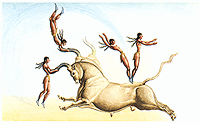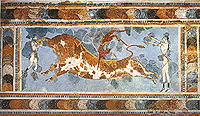 Bull leaping was presumably part of the vernal celebrations and represented the
capture of the sacred bull. In this game the bull leapers grabbed hold of the horns,
executed a risky leap in the air onto the back of the animal and then landed
on the ground. The various representations of bull leaping depict athletes in different
positions. The athletes were not armed but sometimes
had nets to trap the bull and spears,
used not to kill the bull, but to injure it slightly in order to irritate it. Bull leaping was presumably part of the vernal celebrations and represented the
capture of the sacred bull. In this game the bull leapers grabbed hold of the horns,
executed a risky leap in the air onto the back of the animal and then landed
on the ground. The various representations of bull leaping depict athletes in different
positions. The athletes were not armed but sometimes
had nets to trap the bull and spears,
used not to kill the bull, but to injure it slightly in order to irritate it.
|
 This custom seems to be associated with the legend of Minotaur according to which seven young men
and seven young women from Athens were sent each year to Crete to be devoured by
a wild bull. Bull leaping survived until the Classical period in different regions such as
Ephesus, Smyrna, and Sinope. The most celebrated bull leaping games of
Antiquity were those of Thessaly. This custom seems to be associated with the legend of Minotaur according to which seven young men
and seven young women from Athens were sent each year to Crete to be devoured by
a wild bull. Bull leaping survived until the Classical period in different regions such as
Ephesus, Smyrna, and Sinope. The most celebrated bull leaping games of
Antiquity were those of Thessaly. |
| Bull leaping resembles modern bullfighting in Spain.
The main difference lies in the fact that in Minoan Crete the bull was not killed
during the game but later in a special ceremony presided over by priests. |
 Bull leaping was presumably part of the vernal celebrations and represented the
capture of the sacred bull. In this game the bull leapers grabbed hold of the horns,
executed a risky leap in the air onto the back of the animal and then landed
on the ground. The various representations of bull leaping depict athletes in different
positions. The athletes were not armed but sometimes
had nets to trap the bull and spears,
used not to kill the bull, but to injure it slightly in order to irritate it.
Bull leaping was presumably part of the vernal celebrations and represented the
capture of the sacred bull. In this game the bull leapers grabbed hold of the horns,
executed a risky leap in the air onto the back of the animal and then landed
on the ground. The various representations of bull leaping depict athletes in different
positions. The athletes were not armed but sometimes
had nets to trap the bull and spears,
used not to kill the bull, but to injure it slightly in order to irritate it.
 This custom seems to be associated with the legend of Minotaur according to which seven young men
and seven young women from Athens were sent each year to Crete to be devoured by
a wild bull. Bull leaping survived until the Classical period in different regions such as
Ephesus, Smyrna, and Sinope. The most celebrated bull leaping games of
Antiquity were those of Thessaly.
This custom seems to be associated with the legend of Minotaur according to which seven young men
and seven young women from Athens were sent each year to Crete to be devoured by
a wild bull. Bull leaping survived until the Classical period in different regions such as
Ephesus, Smyrna, and Sinope. The most celebrated bull leaping games of
Antiquity were those of Thessaly.